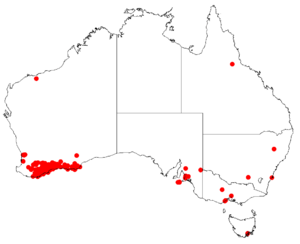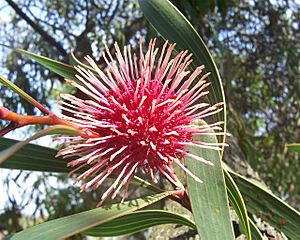Hakea laurina facts for kids
Quick facts for kids Hakea laurina |
|
|---|---|
 |
|
| Hakea laurina inflorescences at different stages of maturity | |
| Scientific classification | |
| Genus: |
Hakea
|
| Species: |
laurina
|
 |
|
| Occurrence data from AVH | |
Hakea laurina is a shrub or small tree. It is also known as kodjet or pin-cushion hakea. This plant grows only in Western Australia. The Noongar people call it kodjet or kojet. It has bright red and cream round flowers. Its leaves are shaped like a spear.
Contents
What Does Hakea laurina Look Like?
Hakea laurina is an upright shrub or a small tree. It has smooth grey bark. It can grow from 2.5 to 6 meters (8 to 20 feet) tall. It can also spread 3 to 5 meters (10 to 16 feet wide). This plant does not form a lignotuber, which is a woody swelling at the base that helps some plants regrow after fire.
Its flower clusters are very noticeable. Each cluster has 120 to 190 flowers. They are white, deep pink, or red. They look like pin cushions and grow where the leaves meet the stem. The small stalks holding the flowers are 5.5 to 9.5 mm long. The flower parts are dark pink to red. The female part of the flower is 14 to 19.5 mm long. It is usually cream-white, but sometimes red or dark pink. Small, scale-like bracts cover the flower buds. Hakea laurina flowers from April to July.
The leaves are simple and a bit blue-green. They are flat and smooth with smooth edges. They are shaped like a spear or an egg. They narrow to a blunt point at the tip. The leaves grow one after another along the branches. They are 7 to 21 cm long and 6 to 29 mm wide. They sit on a stem that is 1 to 2 cm long.
The fruit grows in groups of 1 to 10 per leaf axil. They are 2.2 to 3.8 cm long and 1.6 to 2.3 cm wide. They are egg-shaped and smooth. Sometimes they have rough pits. Each fruit ends in a short beak.
How Hakea laurina Got Its Name
The plant Hakea laurina was first officially described in 1830. This was done by Robert Brown. His description was published in a book called Supplementum primum prodromi florae Novae Hollandiae.
The plant's species name, laurina, comes from the Latin word laurus. This word means "laurel". The name was chosen because the leaves of Hakea laurina look similar to those of the laurel tree.
Where Does Hakea laurina Grow?
The Pincushion Hakea grows in the sandy areas along the coast in southwestern Australia. Its northernmost range is near Narrogin. It stretches east all the way to Esperance.
This plant often grows in sandy plains. Sometimes it can be found in sandy clay. Most of the recorded plants are in the southern parts of its natural plant region.
Growing and Using Hakea laurina
People grow Hakea laurina from seeds. It is grown in the eastern states of Australia. It is also used as a hedge or street plant in America and Italy. This plant can adapt to different types of soil. It can also handle cold weather and frost.
Hakea laurina is used for many things. It is planted for decoration and to provide shade in public streets. It also provides a home for wildlife. Farmers use it as a windbreak to protect their land. It also helps to stop soil from washing away, which is called controlling soil erosion.
In the language of flowers, Hakea laurina has a special meaning. It stands for nobility and long life.
See also
 In Spanish: Hakea laurina para niños
In Spanish: Hakea laurina para niños


